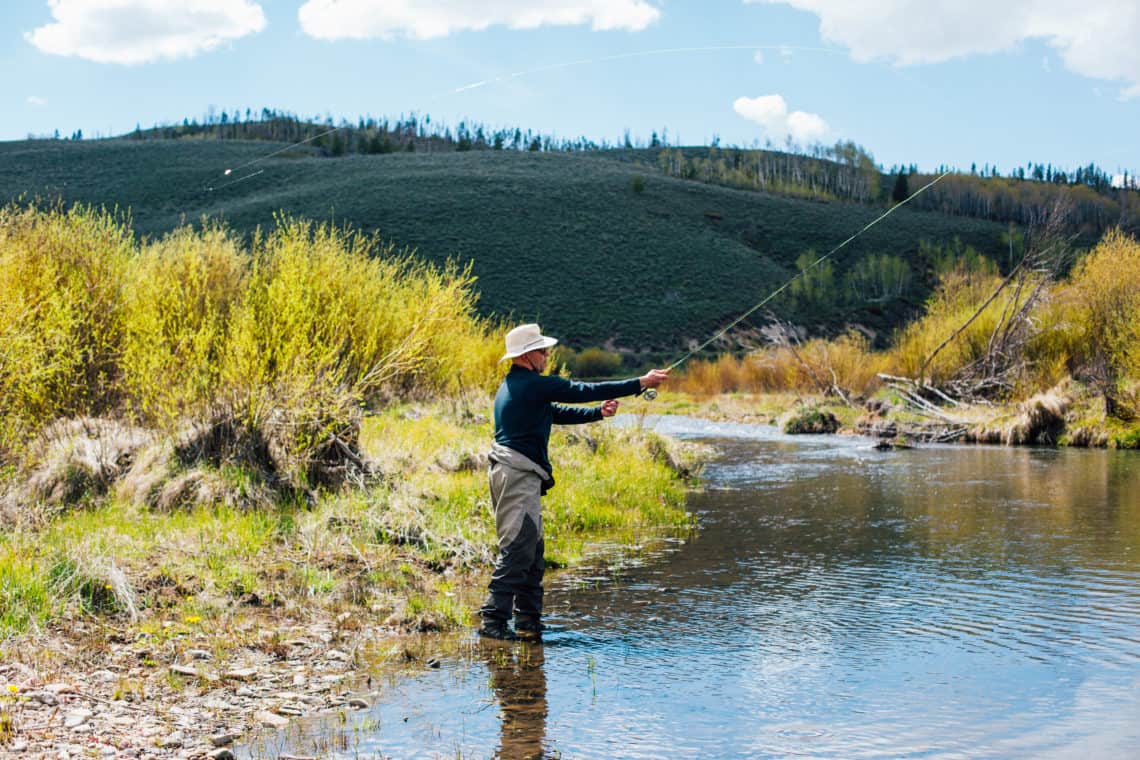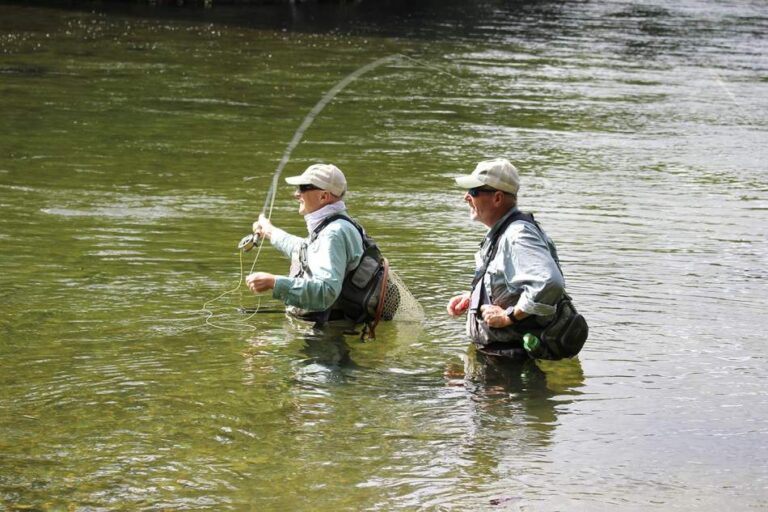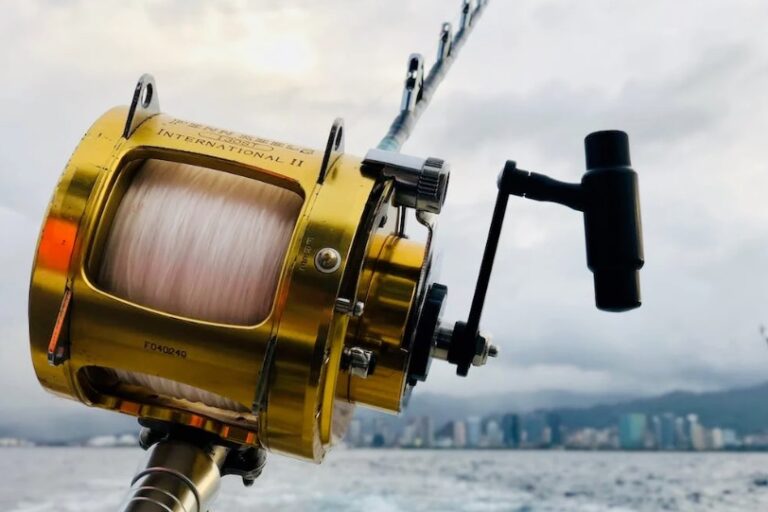Fly fishing and reel fishing are two popular methods of fishing with distinct differences. Fly fishing utilizes lightweight artificial flies that resemble insects, while reel fishing involves the use of a reel to cast and retrieve bait or lures.
Both methods have their unique advantages and can be enjoyed by anglers of different skill levels. We will explore the nuances of fly fishing and reel fishing, highlighting their key characteristics and benefits. Whether you are a beginner or an experienced angler, understanding these differences will help you choose the right fishing technique for your next outdoor adventure.
So, let’s dive in and explore the world of fly fishing and reel fishing in more detail.

Credit: www.clazyu.com
Understanding The Basics Of Fly Fishing And Reel Fishing
Fly fishing and reel fishing are both popular methods of catching fish, but they differ significantly in their approach and techniques. Whether you are a beginner looking to start fishing or an experienced angler looking to try something new, understanding the basics of fly fishing and reel fishing is essential.
In this section, we will explore the difference between the two and discuss the key components of each.
The Difference Between Fly Fishing And Reel Fishing
- Fly fishing involves using a lightweight fly rod, reel, and line to cast an artificial fly onto the water’s surface. The objective is to imitate the movement of insects or other natural prey that fish feed on.
- Reel fishing, on the other hand, involves using a spinning or baitcasting reel attached to a fishing rod. Baits or lures are used to attract fish, and the line is cast into the water, allowing the angler to retrieve the line and entice the fish to bite.
Key Components Of Fly Fishing
- Fly rod: A specialized lightweight and flexible rod designed for casting the lightweight fly line.
- Fly reel: A device attached to the rod used to hold the fly line and provide smooth line retrieval.
- Fly line: A specialized line that is typically thicker and heavier than conventional fishing lines, allowing for efficient casting and delicate presentation of the fly.
- Flies: Artificial imitations of insects or small creatures, tied with various materials and techniques to resemble natural prey.
- Fly casting: The technique of propelling the fly line forward to deliver the fly to the desired location using a variety of casting methods.
Key Components Of Reel Fishing
- Fishing rod: A rod designed specifically for reel fishing, usually longer and sturdier than fly rods, with different actions designed for specific fishing styles.
- Fishing reel: A device attached to the fishing rod that houses the fishing line and allows for efficient line retrieval.
- Fishing line: The line used in reel fishing, which can vary in strength, visibility, and material depending on the fishing conditions and target species.
- Baits and lures: Artificial or natural substances used to attract fish, such as worms, minnows, or artificial lures designed to imitate prey.
- Casting and retrieval: The technique of casting the line into the water and retrieving it to entice fish to bite.
Understanding the basics of fly fishing and reel fishing is crucial to selecting the right equipment, tactics, and approach for your fishing adventures. Both methods offer unique experiences and challenges, and choosing between them ultimately depends on your preferences and the fishing conditions.
Pros Of Fly Fishing
Enhanced Versatility And Mobility
Fly fishing offers a range of advantages over traditional reel fishing. One of the key benefits is its enhanced versatility and mobility. Here are some key points to consider:
- Fly fishing allows anglers to cover a wider range of fishing scenarios. You can successfully target various species in different environments, including freshwater rivers, lakes, and even saltwater flats.
- With fly fishing, you can explore different techniques and adapt to changing conditions. Whether you’re imitating a specific insect or using streamers to mimic baitfish, the possibilities are endless. This versatility allows you to experiment and customize your approach based on what works best in each situation.
- Fly fishing also provides anglers with increased mobility. Unlike traditional reel fishing, which requires large amounts of equipment, fly fishing requires minimal gear. This means you can easily move from one fishing spot to another without being weighed down by heavy tackle.
- Due to its portability, fly fishing is particularly well-suited for exploring remote and hard-to-reach areas. You can hike to secluded mountain streams or wade in shallow creeks that are inaccessible to conventional gear. This opens up a whole new world of fishing opportunities.
Precision And Delicate Presentation
Another advantage of fly fishing is its ability to offer precise and delicate presentation. Here are some key points to consider:
- Fly fishing allows for more accurate casting and presentation of your fly. With the right technique, you can place your fly with pinpoint accuracy, whether it’s on a specific pocket of water or near a target structure where fish are hiding. This precision increases your chances of success.
- The lightweight nature of fly fishing gear enables delicate presentation. The minimal weight of the fly and the thin fly line allow for subtle entries on the water’s surface, mimicking the natural movements of insects. This delicate approach is crucial when targeting selective or skittish fish.
- It’s important to note that with traditional reel fishing, the weight of the bait or lure can create a significant disturbance upon entry into the water, potentially scaring away wary fish. Fly fishing eliminates this issue, allowing for a more realistic and stealthy presentation.
- The ability to present your fly gently and precisely enhances the overall fishing experience. It requires finesse, strategy, and a deep understanding of the fish’s behavior, making it a rewarding and satisfying fishing technique.
Immersive And Engaging Experience
One of the unique aspects of fly fishing is the immersive and engaging experience it offers. Here are some key points to consider:
- Fly fishing involves a more hands-on and interactive approach compared to traditional reel fishing. The angler is actively involved in every aspect, from tying the flies to casting and manipulating the line. This level of engagement enhances the overall fishing experience.
- Due to the up-close and personal nature of fly fishing, anglers have a heightened connection with the environment. You can observe insects and their behavior, study the water’s flow, and understand the fishes’ feeding patterns. This connection with nature adds an extra layer of enjoyment to the fishing experience.
- Fly fishing also encourages a deeper appreciation for the artistry and craftsmanship involved. Tying flies is an intricate process that allows anglers to create their own custom patterns, adding a creative element to the sport. This customization adds to the overall immersive experience.
- The rhythmic and graceful casting motions of fly fishing contribute to the overall enjoyment. The casting process itself is akin to a dance, with the angler casting, mending, and manipulating the line to achieve the desired presentation. This fluidity and artistry make fly fishing both visually appealing and mentally engaging.
Greater Control And Sensitivity
Fly fishing provides anglers with greater control and sensitivity, enhancing their overall fishing experience. Here are some key points to consider:
- With fly fishing, anglers have direct control over the movement and action of the fly. Through the manipulation of the fly line and the use of various retrieves, you can impart lifelike movements to the fly, enticing fish to strike. This level of control allows for a more precise and targeted approach.
- The lightweight fly fishing gear enables increased sensitivity to subtle strikes. Since there is no heavy bait or lure that can dampen the sensation, anglers can feel even the slightest take from a fish. This heightened sensitivity improves the angler’s ability to detect bites and increases the chances of hooking fish.
- The finer gear used in fly fishing allows for a more connected experience with the fish. The delicate balance of the tackle and the constant feedback from the line provide a more intimate connection between the angler and the fish. This connection amplifies the thrill and excitement of the catch.
- The increased control and sensitivity afforded by fly fishing facilitate a deeper understanding of the underwater world. Anglers can read the water, interpret fish behavior, and make real-time adjustments to their technique. This level of involvement and interaction adds depth and challenge to the fishing experience.
Cons Of Fly Fishing
Fly fishing is a popular method of fishing that involves using a lightweight fishing line and an artificial fly to lure fish. While it has its advantages, such as offering a more immersive and traditional fishing experience, it also has some drawbacks.
In this section, we will explore the cons of fly fishing and why it may not be the best choice for everyone.
Steeper Learning Curve
Fly fishing is not as straightforward as using a reel and bait. It requires a certain level of skill and technique, making it more challenging for beginners to pick up. Here are some key points to consider:
- Fly fishing involves specialized casting techniques, such as the roll cast, double haul, and sidearm cast.
- The angler needs to learn how to effectively control the fly line and make precise presentations to the fish.
- Understanding insect hatches, fly selection, and reading the water are essential skills in fly fishing.
Requires More Skill And Technique
Compared to using a reel, fly fishing demands a higher level of skill and technique. Here are a few points to keep in mind:
- Casting with a fly rod requires finesse and accuracy. It takes time and practice to achieve a smooth and efficient cast.
- Since the line is lightweight, the angler needs to rely on the rod’s flexibility and their wrist action to generate the necessary power for casting.
- Properly presenting the fly to the fish requires precise control of the line, mimicking the natural movements of insects or baitfish.
Limited Distance And Casting Accuracy
One of the limitations of fly fishing is its restricted distance and casting accuracy. Consider the following points:
- The lightweight fly line does not carry as much momentum as a traditional fishing line, resulting in shorter casting distances.
- Achieving pinpoint accuracy when casting is more challenging due to the nature of the casting techniques and the need for delicate presentations.
- Fly fishing is better suited for fishing in smaller streams, rivers, and lakes where short to medium-range casting is sufficient.
Certain Limitations In Targeting Large Fish
While fly fishing can be effective for a variety of fish species, it may have limitations when it comes to large fish. Here’s what to keep in mind:
- The lighter tackle used in fly fishing may not have the strength and capacity required to handle sizable fish.
- Landing larger fish on a fly rod can be more difficult, as the drag system on fly reels is typically not as robust as those found on traditional fishing reels.
- Targeting larger fish may require specialized equipment and techniques that go beyond the scope of traditional fly fishing.
While fly fishing offers a unique and enjoyable fishing experience, it’s essential to consider its cons. The learning curve, skill requirements, limited casting distance, and certain limitations in targeting large fish make it a less suitable option for some anglers.
Nonetheless, for those willing to invest the time and effort to master the art of fly fishing, the rewards can be well worth it.
Pros Of Reel Fishing
Fly fishing and reel fishing are two popular methods for casting a line and reeling in fish. While fly fishing is often praised for its grace and artistry, reel fishing certainly has its advantages. In this section, we will explore the pros of reel fishing, including its longer casting range and accuracy, its suitability for targeting larger fish, its easier learning curve and mastery, and its versatility in terms of lures and fishing techniques.
Longer Casting Range And Accuracy
- With reel fishing, anglers can cast their line over longer distances compared to fly fishing. This allows them to reach fish that are located farther away, increasing their chances of a successful catch.
- The design of fishing reels, specifically the spinning and baitcasting reels, enables anglers to cast their line with great accuracy. This precision is particularly beneficial when trying to cast into specific spots where fish may be hiding or where optimal conditions exist.
Suitable For Targeting Larger Fish
- Reel fishing is often the preferred method when targeting larger fish species, such as bass, pike, or muskie. The strength and durability of fishing reels, along with their ability to handle heavier lines and lures, make them better suited for these types of fishing scenarios.
- When battling with bigger fish, the drag system of fishing reels provides anglers with greater control over the line tension and helps to prevent line breakage. This increased control allows for a more successful fight with the fish and ultimately increases the chances of landing it.
Easier To Learn And Master
- Compared to fly fishing, reel fishing is generally easier to learn and master. The basic techniques and mechanics of reel fishing, such as casting and reeling, can be quickly grasped, making it an ideal choice for beginners or those looking for a more straightforward fishing experience.
- The learning curve for reel fishing is often less steep than that of fly fishing, as it does not require the complex casting techniques and specialized gear associated with fly fishing. With a little practice, anglers can become proficient in reel fishing and enjoy successful fishing outings.
Variety Of Lures And Fishing Techniques
- Reel fishing offers anglers a wide range of lures and fishing techniques to choose from. Whether using artificial lures, live bait, or even trolling, there are countless options for attracting fish with a fishing reel.
- Different fishing techniques, such as bottom fishing, topwater fishing, or jigging, can be easily employed with fishing reels. This versatility allows anglers to adapt their approach based on the location, target species, and prevailing conditions, increasing their chances of a successful and enjoyable fishing experience.
Reel fishing has several advantages that make it a popular choice among anglers. Its longer casting range and accuracy, suitability for targeting larger fish, easier learning curve, and versatility in lures and fishing techniques make it an appealing option for anglers of all skill levels.
So grab your fishing reel, choose your favorite fishing spot, and get ready to reel in your next catch!
Cons Of Reel Fishing
Fly fishing and reel fishing are two popular methods for catching fish, each with its own set of advantages and disadvantages. In this blog post, we will focus on the cons of reel fishing. Although reel fishing has its merits, it’s important to understand some of the drawbacks before choosing this method.
Let’s explore the key points below.
Less Delicate And Subtle Presentation
- Unlike fly fishing, reel fishing often lacks the delicate and subtle presentation that can be achieved with flies or lures.
- Reel fishing typically relies on bait and heavy tackle, which might not be as enticing to certain species of fish.
- This could reduce your chances of successfully targeting fish that require a more precise and natural presentation.
Reliance On Appropriate Reel And Line Setup
- Reel fishing requires a suitable reel and line setup to ensure smooth casting and retrieval.
- Choosing the wrong reel or line weight can lead to poor performance and frustrations.
- It’s crucial to match your reel and line setup to the size of the fish you intend to catch, and the conditions you’ll be fishing in.
Restricted Access To Certain Areas
- Reel fishing can be limited by the accessibility of certain fishing areas.
- Compared to the versatility of fly fishing, which allows for casting in tight spaces and shallow water, reel fishing might struggle in such conditions.
- This limitation could impact your ability to reach prime fishing spots and potentially decrease your chances of success.
Potential For Snags And Tangles
- Due to the nature of using bait and hooks, reel fishing carries a higher risk for snags and tangles.
- Vegetation, rocks, or underwater structures can easily snag your line or bait, resulting in lost tackle or interrupted fishing.
- It’s important to be mindful of the surroundings and take precautions to prevent unwanted entanglements.
Reel fishing offers its own unique experience and advantages, but it’s crucial to be aware of the drawbacks. Understanding the less delicate and subtle presentation, the reliance on appropriate reel and line setup, the restricted access to certain areas, and the potential for snags and tangles can help you make an informed decision about which fishing method suits your needs and preferences.
So, consider these factors when deciding between fly fishing and reel fishing for your next angling adventure.
Choosing The Right Fishing Method For Your Needs
Fly fishing vs reel fishing: choosing the right fishing method for your needs
When it comes to fishing, there are various methods and techniques to choose from, and two popular options are fly fishing and reel fishing. Both methods have their pros and cons, making it essential to consider a few key factors before deciding which one is right for you.
In this section, we will explore the factors to consider when choosing between fly fishing and reel fishing, including assessing your skill level and learning potential, determining your target species and fishing environment, and evaluating personal preferences and fishing goals.
Factors To Consider When Choosing Between Fly Fishing And Reel Fishing
Fly fishing and reel fishing have unique characteristics that appeal to different individuals. To make an informed decision, here are a few factors to consider:
- Assessing your skill level and learning potential:
- Fly fishing requires more skill and technique than reel fishing. If you’re a beginner or looking for a more straightforward fishing experience, reel fishing might be the better option.
- Fly fishing offers a rewarding challenge and endless room for improvement. If you’re passionate about learning new techniques and honing your angling skills, fly fishing could be the perfect fit.
- Determining your target species and fishing environment:
- Fly fishing is particularly effective in freshwater environments, such as rivers and streams, where fish are surface-feeding or close to the surface.
- Reel fishing is versatile and suitable for various fishing environments, including freshwater lakes, saltwater coastlines, and deep-sea fishing ventures.
- If your target species primarily consists of trout, salmon, bass, or other freshwater fish, fly fishing is an excellent method. On the other hand, if you’re aiming for larger saltwater species, like marlin or tuna, reel fishing is more suitable.
- Evaluating personal preferences and fishing goals:
- Fly fishing offers a more immersive experience, allowing anglers to connect with nature and enjoy the tranquility of the water. It’s a method that focuses on technique and finesse.
- Reel fishing is often preferred by those seeking a more relaxed and straightforward fishing outing. It allows for a greater focus on socializing and enjoying the surroundings.
- Consider your personal preferences and fishing goals. If you value solitude and the artistry of angling, fly fishing may be your preferred choice. On the other hand, if you enjoy a more relaxed and social fishing experience, reel fishing would be a better fit.
By carefully evaluating your skill level, target species, fishing environment, personal preferences, and goals, you can make an informed decision between fly fishing and reel fishing. Remember, there’s no right or wrong choice – it all depends on what resonates with you as an angler.
So, grab your gear, head to the water, and embark on an unforgettable fishing adventure!
Tips For Successful Fly Fishing
Fly fishing is a popular and rewarding sport that requires skill, patience, and the right techniques. Whether you are a beginner or an experienced angler, there are some essential tips that can help you have a successful fly fishing experience.
In this section, we will discuss the key points under the subheading: tips for successful fly fishing.
Essential Fly Fishing Gear And Equipment
To ensure a successful fly fishing trip, it is important to have the right gear and equipment. Here are some essentials you should consider:
- Fly rod and reel: Choose a rod and reel that is suitable for the type of fish you will be targeting. Consider the weight of the rod and the line weight it can handle.
- Fly line: Select a fly line that matches the weight of your rod. Different types of fly lines are designed for different fishing conditions.
- Leaders and tippets: These are used to connect the fly to the fly line. It is crucial to choose the right length and strength based on the size of the fly and the fish you are targeting.
- Flies: There is a wide variety of fly patterns available to imitate different insects and baitfish. Make sure to carry a selection of flies that are suitable for the fish species you are targeting.
- Waders and boots: If you plan on fishing in rivers or streams, having a pair of waders and boots will keep you dry and provide better access to fishing spots.
- Accessories: Don’t forget to bring additional items like a fly box, forceps, nippers, and a landing net to enhance your fly fishing experience.
Basic Fly Casting Techniques
Mastering the art of fly casting is essential for successful fly fishing. Here are some key techniques to focus on:
- Grip and stance: Hold the fly rod with a relaxed grip and maintain a balanced stance to allow for smooth and accurate casting.
- Backcast and forward cast: Practice the backcast and forward cast motion to create a smooth and controlled casting stroke. Keep your wrist firm and use your forearm and shoulder to generate power.
- Timing and rhythm: Develop a consistent timing and rhythm for your casting motion. The pause between the backcast and forward cast is crucial for loading the rod and delivering the fly accurately.
- Line control: Learn how to mend, mend, and mend! Correctly mending the line will enable a drag-free presentation, increasing your chances of enticing a fish to bite.
- Accuracy and distance: Aim for accuracy in your casting to place the fly in the desired target area. As your skills progress, work on increasing your casting distance to reach fish that are far away.
Fly Selection And Fly Tying
Choosing the right fly and learning how to tie your own can greatly improve your chances of success. Here are some important points to consider:
- Match the hatch: Observe the insects on and around the water to determine the most prevalent species. Select a fly that closely resembles the natural insects that fish are feeding on.
- Experiment with different patterns: Don’t be afraid to try different fly patterns until you find what works best for the fish you are targeting. Pay attention to color, size, and presentation.
- Learn to tie your own flies: Tying your own flies allows you to customize and imitate specific patterns. It can also be a rewarding and creative aspect of fly fishing.
Locating Fish And Reading The Water
Knowing where to find fish and understanding the water conditions are key elements of successful fly fishing. Consider these points:
- Look for structure: Fish are often found near underwater structures such as rocks, fallen trees, and weed beds. These areas provide shelter and food sources.
- Watch for feeding signs: Keep an eye out for rising fish, feeding disturbances, or insect activity on the water’s surface. These signs can indicate the presence of fish and the type of insects they are feeding on.
- Understand water currents: Fish will often position themselves in areas with slower currents where they can conserve energy and wait for food to come to them.
- Adjust to changing conditions: Be adaptable and willing to explore different areas of the water. Fish may change their feeding patterns based on weather conditions, water temperature, and time of day.
By following these essential tips, you will be well on your way to having a successful fly fishing adventure. Remember to practice, be patient, and enjoy the beauty of nature as you pursue your passion for this captivating sport. Happy fishing!
Tips For Successful Reel Fishing
Fly fishing may be the more glamorous cousin, but don’t underestimate the thrill and excitement of reel fishing. With the right techniques and gear, reel fishing can be just as rewarding. In this section, we will explore some essential tips for successful reel fishing.
From choosing the right gear and tackle to mastering casting techniques, we’ve got you covered.
Essential Reel Fishing Gear And Tackle
- Fishing rod: Opt for a medium to heavy-action fishing rod, around 6 to 7 feet long, to have enough power and flexibility to handle a variety of fish species.
- Fishing line: Consider using a monofilament or braided fishing line. Monofilament is more versatile, while braided lines offer increased strength and sensitivity.
- Reel: Select a spinning reel that matches the size of your rod and fishing line.
- Fishing hooks: Use a variety of sizes and styles of fishing hooks, depending on the targeted fish species.
- Sinkers and bobbers: Keep a variety of sinkers and bobbers to adjust the depth at which your bait or lure is presented.
- Fishing baits and lures: Experiment with a mix of live bait such as worms or minnows, as well as artificial lures like crankbaits, spinners, and soft plastics.
Casting Techniques For Reel Fishing
- Overhead cast: The most common casting technique, where you bring the rod overhead and forward with a smooth motion.
- Sidearm cast: Suitable for fishing in tight areas or under obstacles, the sidearm cast involves a sideways motion with the rod parallel to the water surface.
- Roll cast: Perfect for limited backcasting space, the roll cast involves a short snap of the rod tip to quickly send the line forward.
- Pitching: A short-distance cast, pitching involves swinging the rod forward with a flick of the wrist to drop your bait or lure accurately in a specific spot.
- Flipping: Similar to pitching, flipping is a technique used in close-quarters fishing, where you flip your bait or lure with minimal casting motion.
Choosing The Right Lures And Bait
- Research the targeted fish species: Understand the feeding habits, preferred habitats, and behavior patterns of the fish you want to catch.
- Match the hatch: Select lures and bait that mimic the natural prey available in the fishing location.
- Use the right color and size: Consider the water clarity and visibility conditions when choosing the color and size of your lures or bait.
- Experiment with different types: Try a combination of lures such as crankbaits, topwater lures, and soft plastics to entice different fish species.
- Live bait options: Worms, minnows, and nightcrawlers are popular choices for attracting a wide range of fish.
Identifying And Attracting Fish Species
- Observe the water: Look for signs of fish activity such as jumping or splashing to determine potential hotspots.
- Use fish finders: Invest in a fish finder device to detect underwater structures and locate fish schools.
- Learn about fish behavior: Understand the feeding patterns, migration routes, and preferred habitats of the fish species you are targeting.
- Experiment with different depths: Vary the depth at which you present your bait or lure to determine where the fish are actively feeding.
- Stay patient and observant: Pay attention to small details like changing water temperature, wind patterns, and underwater disturbances.
With these tips in mind, you’ll be well-equipped to enjoy successful reel fishing adventures. Remember to always respect fishing regulations and practice responsible angling techniques. Now, grab your gear, head to the nearest fishing spot, and get ready to reel in some thrilling catches!
Conclusion
Having examined the pros and cons of fly fishing and reel fishing, it is clear that both have their own unique advantages and appeal to different types of anglers. Fly fishing offers a more immersive and traditional experience, allowing for greater precision and finesse.
On the other hand, reel fishing provides a convenient and accessible option for beginners or those looking for a more relaxed fishing experience. Both methods have their merits and can be enjoyable in their own ways. Ultimately, the choice between fly fishing and reel fishing depends on personal preferences, fishing goals, and the specific fishing conditions.
Whether you prefer the artistry and challenge of fly fishing or the simplicity and ease of reel fishing, both options offer the opportunity to connect with nature and experience the thrill of catching fish. So, choose the method that suits you best and enjoy the wonderful world of fishing!





